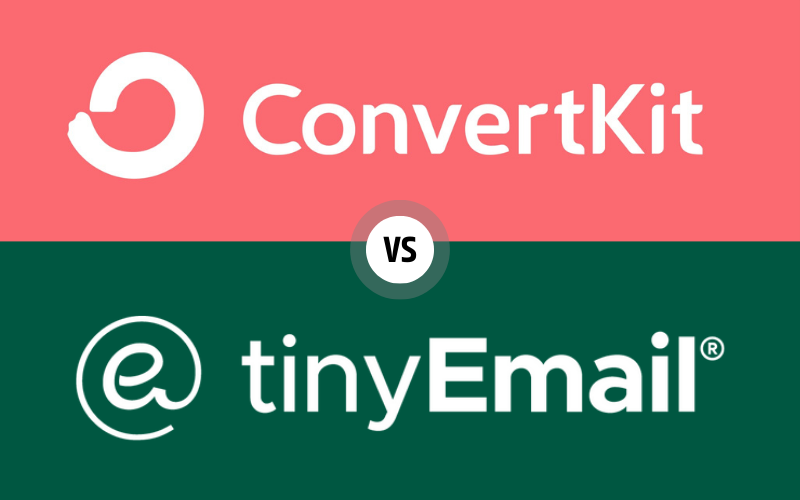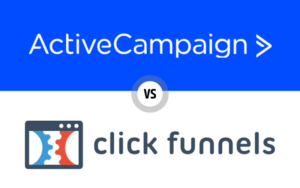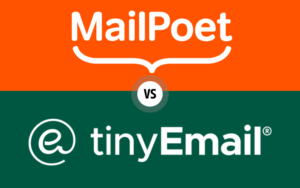In the vast world of email marketing platforms, the debate of ConvertKit vs TinyEmail has been gaining traction among businesses and digital marketers alike. Both platforms have carved a niche for themselves, each boasting unique features and histories that set them apart in a crowded marketplace.
ConvertKit, a favorite among bloggers and content creators, has a rich history of providing user-friendly tools tailored for seamless audience engagement. Its evolution has been marked by constant updates and adaptations to the ever-changing digital landscape.
TinyEmail, although a newer entrant, has quickly risen in popularity thanks to its modern approach and cloud-based infrastructure. Embracing the needs of today’s marketers, it promises agility and scalability right out of the box.
As we dive deep into this comparison, we’ll shed light on each platform’s strengths, challenges, and key differentiators. By the end, you’ll have a clearer picture of which tool aligns best with your email marketing goals.
Table of Contents
Ease of Use and Interface
Choosing an email marketing tool involves understanding how its interface will influence your daily workflow. A user-friendly platform not only makes tasks seamless but also reduces the learning curve. In this category, we’ll break down the user experience and interface design of both ConvertKit and TinyEmail.
ConvertKit
ConvertKit has garnered attention for its intuitive and clean interface. Geared towards creators and bloggers, ConvertKit focuses on simplicity, ensuring that even those new to email marketing can navigate effortlessly. Features are well-organized, and setting up a campaign or designing an email feels straightforward.

TinyEmail
TinyEmail, with its modern UI approach, emphasizes both aesthetics and functionality. The dashboard provides a bird’s eye view of your campaigns, and frequently used tools are easily accessible. Its drag-and-drop editor, along with clear labeling, ensures tasks such as list segmentation or template design are a breeze.
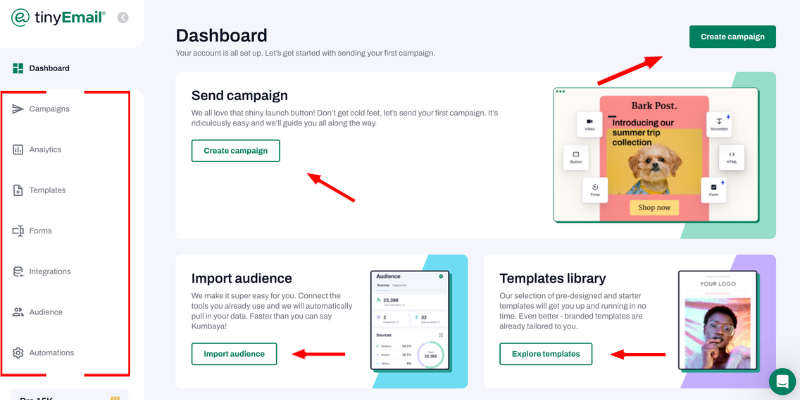
Comparison
In the face-off between ConvertKit vs TinyEmail regarding ease of use and interface, both platforms shine in their unique ways. ConvertKit provides simplicity tailored for creators, while TinyEmail’s contemporary design makes it a favorite for those seeking a blend of elegance and efficiency. Your choice might boil down to personal preference, depending on which layout feels more intuitive to you.
Email Design and Templates
A stunning email design not only captivates your audience but also conveys your message more effectively. The availability and quality of templates, coupled with design flexibility, can greatly influence your email marketing success. Let’s explore how ConvertKit and TinyEmail fare in this domain.
ConvertKit
ConvertKit emphasizes simplicity, providing a selection of minimalist yet impactful templates. While it may not boast a vast library, the available designs are optimized for readability and mobile responsiveness. Their editor is easy to use, allowing users to tweak templates or create designs from scratch without needing coding knowledge.

TinyEmail
TinyEmail, on the other hand, offers a diverse array of templates catering to various industries and occasions. Whether you’re announcing a product launch, sharing a newsletter, or promoting a sale, there’s a template tailored for your needs. The platform’s drag-and-drop editor further amplifies the design process, enabling users to customize templates with ease, ensuring brand consistency.

Comparison
When pitting TinyEmail vs ConvertKit in the realm of email design and templates, it’s a matter of quantity versus curated quality. ConvertKit’s designs are crisp and cater to creators who appreciate straightforwardness. TinyEmail, however, provides a broader spectrum of design choices, giving businesses the flexibility to align their emails closely with their brand aesthetics.
Automation Capabilities
In today’s fast-paced digital marketing landscape, automation is no longer a luxury—it’s a necessity. Efficient automation tools enable businesses to deliver timely and personalized content, elevating the overall user experience. Let’s delve into the automation capabilities of ConvertKit and TinyEmail.
ConvertKit
ConvertKit is well-renowned for its robust automation capabilities. Their visual automation builder offers a clear, intuitive interface where users can design intricate workflows based on subscriber actions or other predefined triggers. With ConvertKit, automating email sequences, segmenting audiences based on behavior, and even setting up complex sales funnels becomes a seamless task.

TinyEmail
TinyEmail steps up to the plate with a comprehensive suite of automation features. Beyond the basic email sequences, TinyEmail offers tools for advanced behavioral triggers, A/B testing within automations, and even predictive sending based on a user’s optimal engagement time. Their automation analytics are also noteworthy, providing insights that help refine and optimize campaigns over time.
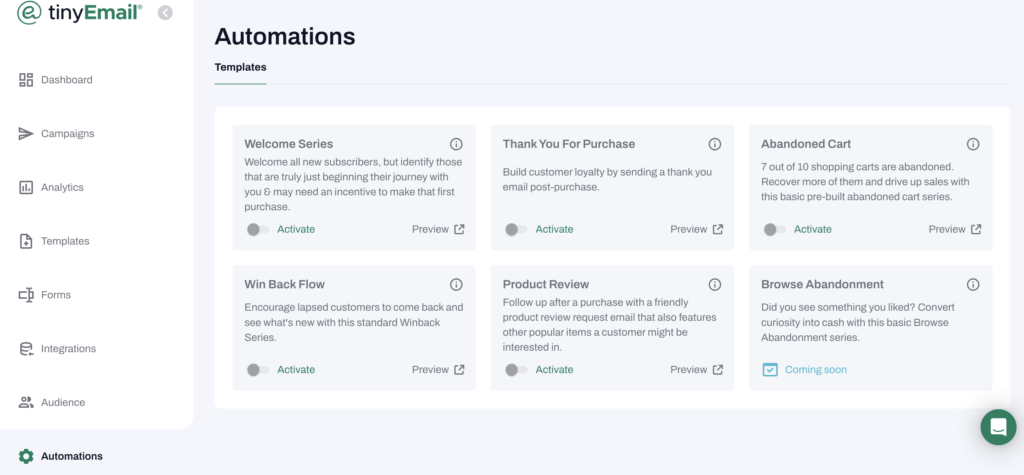
Comparison
In the contest of automation between ConvertKit vs TinyEmail, both platforms exhibit strengths. ConvertKit’s visual builder is an asset for those who appreciate clarity and simplicity in design, making automation setup a breeze. TinyEmail, with its broad range of advanced tools and in-depth analytics, caters to businesses keen on extracting the maximum potential out of their email campaigns.
Segmentation and Personalization
In an age where consumers expect tailored experiences, segmentation and personalization have become central to effective email marketing. By grouping subscribers based on shared attributes or behaviors and delivering customized content, marketers can drive higher engagement and conversion rates. Let’s evaluate how ConvertKit and TinyEmail fare in this crucial domain.
ConvertKit
ConvertKit emphasizes the power of precise targeting. Users can effortlessly segment their subscribers based on multiple criteria such as location, purchase behavior, or interaction with previous emails. Additionally, ConvertKit’s tagging system allows for intricate personalization. By tagging subscribers based on actions they take, marketers can craft highly personalized emails that resonate on an individual level.

TinyEmail
TinyEmail champions a holistic approach to segmentation and personalization. Their platform supports both broad category-based segments and micro-segments based on detailed subscriber behaviors. Dynamic content insertion is another standout feature, letting marketers tailor specific parts of an email to individual subscriber profiles, ensuring a unique experience for every recipient.

Comparison
When assessing segmentation and personalization in ConvertKit vs TinyEmail, both tools exhibit a strong commitment to delivering personalized user experiences. ConvertKit’s straightforward tagging and segmenting system is a boon for those looking to quickly and effectively tailor their content. Meanwhile, TinyEmail’s dynamic content feature, combined with its advanced segmentation capabilities, caters to marketers seeking a granular approach to customization.
List Management and Import
Managing a growing email list is paramount to maintaining organized campaigns and achieving optimal results. An efficient system not only helps marketers segment and target their audience effectively but also ensures a smooth import and integration of new contacts. Here, we’ll dive into how ConvertKit and TinyEmail handle list management and the import process.
ConvertKit
One of ConvertKit’s most applauded features is its straightforward list management. It adopts a single list approach, where every subscriber is part of one master list but can be segmented using tags and custom fields. This prevents duplicate entries and ensures cleaner data. When it comes to importing contacts, ConvertKit facilitates seamless migrations from other platforms with its intuitive import tool, ensuring a hassle-free transition for marketers switching to or integrating with their system.

TinyEmail
TinyEmail, on the other hand, offers a flexible system for list management. It supports both single and multiple list setups, catering to varying marketer preferences. Its drag-and-drop feature simplifies the reorganization of subscribers among different lists. For imports, TinyEmail provides a robust tool that recognizes various file formats and integrates with numerous CRM platforms, making the addition of new contacts to the system smooth and efficient.
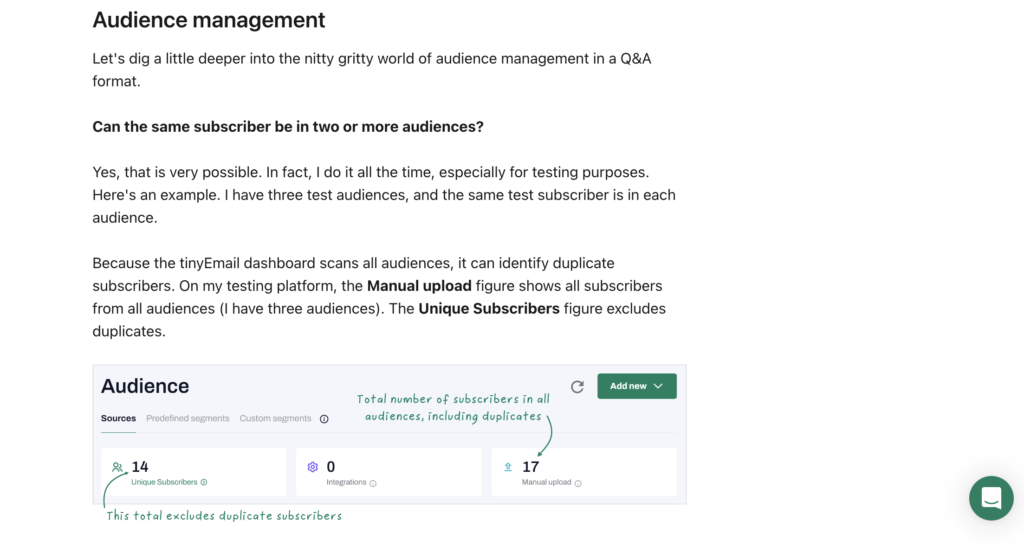
Comparison
Tackling list management and import in ConvertKit vs TinyEmail presents distinct approaches. ConvertKit’s single list strategy, complemented by its tagging system, is a great fit for those desiring simplicity and data cleanliness. In contrast, TinyEmail’s multifaceted approach offers more versatility, particularly appealing to marketers who manage multiple campaigns and require varied list setups.
Integration Capabilities
In today’s digital age, integrating various tools and platforms is crucial for streamlining operations and ensuring efficiency in marketing campaigns. The more seamless an email marketing platform integrates with other solutions, the easier it becomes for marketers to consolidate data, analyze insights, and drive conversions. In this section, we explore how ConvertKit and TinyEmail fare in terms of their integration capabilities.
ConvertKit
ConvertKit boasts an extensive list of integrations with popular e-commerce platforms, CRM systems, membership sites, and landing page builders. Popular integrations include Shopify, WooCommerce, Zapier, and LeadPages, ensuring that data flows seamlessly across different channels. Their API is well-documented, providing tech-savvy users and developers the freedom to create custom integrations tailored to unique needs.

TinyEmail
TinyEmail’s approach to integration underscores its modern and adaptive design. While they offer direct integrations with leading e-commerce platforms and CRM solutions, their trump card is the integration with Zapier. This allows TinyEmail to connect with thousands of apps, expanding its integration horizon exponentially. For businesses operating on custom or less common platforms, TinyEmail also provides a robust API for tailored integrations.

Comparison
When juxtaposing integration capabilities of ConvertKit vs TinyEmail, both platforms showcase robust offerings. ConvertKit’s well-established integration network caters to a vast majority of marketers, while TinyEmail’s expansive connectivity via Zapier positions it as a highly adaptable choice for diverse business needs.
Deliverability Rates
The essence of email marketing lies in ensuring that your messages actually reach the inboxes of your subscribers. Deliverability rates represent a critical metric in assessing the effectiveness of an email marketing platform. High deliverability rates mean better chances of your emails landing in the main inbox rather than spam folders. In this segment, we delve into the deliverability rates of ConvertKit and TinyEmail to ascertain their efficacy.
ConvertKit
ConvertKit has invested heavily in its infrastructure and authentication tools to optimize deliverability rates. With a reputed track record, ConvertKit claims a high deliverability rate, often surpassing the industry average. Their platform emphasizes the importance of authentications like SPF, DKIM, and DMARC, ensuring that emails sent are trustworthy and compliant. Regular audits and close partnerships with major email providers, like Gmail and Yahoo, further solidify ConvertKit’s standing in the deliverability domain.

TinyEmail
TinyEmail’s modern infrastructure has been built from the ground up with deliverability as a core focus. Their proactive approach includes continuous monitoring, instant feedback on potential issues, and guidance on best email practices to ensure optimal delivery. Like ConvertKit, TinyEmail also emphasizes the importance of proper email authentication and offers comprehensive tools to assist marketers in achieving this. Their transparent reporting provides users with insights into delivery rates, bounces, and potential reasons for non-deliveries.
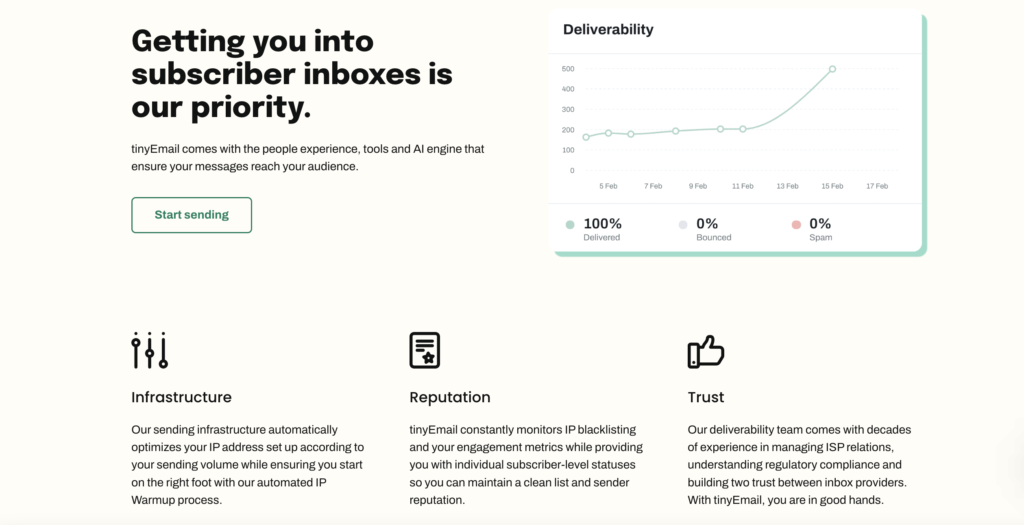
Comparison
In the showdown of deliverability rates between ConvertKit vs TinyEmail, both platforms demonstrate a commitment to ensuring that emails reach their intended recipients. While ConvertKit has a longstanding reputation in the arena, TinyEmail’s transparency and innovative approach bring fresh dynamics to the table.
Reporting and Analytics
Understanding the performance of email campaigns is crucial for refining strategies and achieving desired outcomes. Comprehensive reporting and analytics tools help marketers glean insights, identify areas of improvement, and gauge the return on investment. In this section, we will dissect the reporting and analytics capabilities of ConvertKit and TinyEmail.
ConvertKit
ConvertKit offers an intuitive dashboard that presents key metrics at a glance, such as open rates, click-through rates, and subscriber growth. Additionally, their platform provides deeper dives into individual campaign performances, visual automations, and subscriber activities. ConvertKit allows marketers to segment reports, facilitating more tailored analyses based on specific lists or tags. Their visual reports make it easy to comprehend data and draw actionable insights.
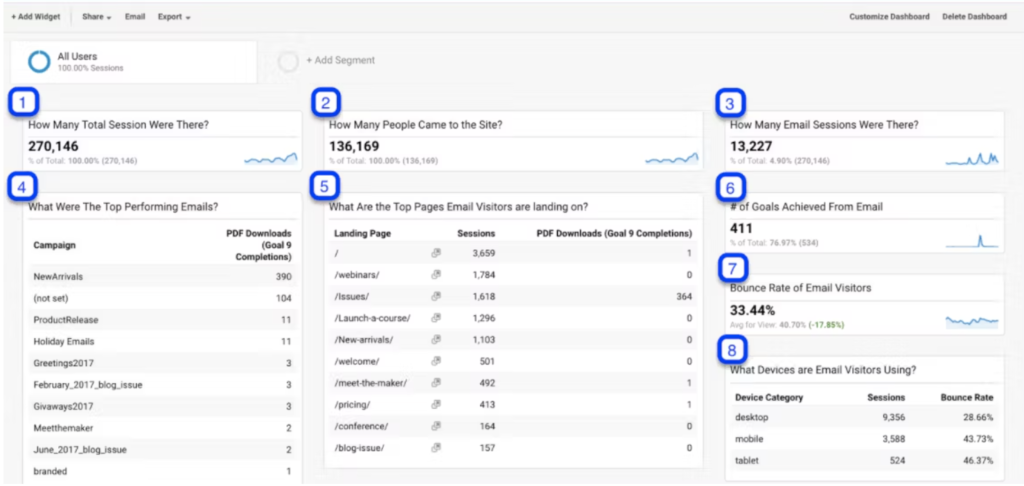
TinyEmail
TinyEmail stands out with its modern, streamlined analytics interface. Offering real-time data, TinyEmail gives marketers an immediate pulse on how campaigns are performing. Beyond the standard metrics, TinyEmail offers advanced tracking, including heat maps, geolocation of opens, and engagement over time. One distinctive feature is its ability to integrate with third-party analytics tools, ensuring a seamless flow of data across platforms and enabling more holistic analyses.

Comparison
When evaluating the reporting and analytics prowess in the TinyEmail vs ConvertKit debate, it’s evident that both platforms offer robust tools to satiate marketers’ analytical needs. ConvertKit’s user-friendly interface and segmented reports cater to both novices and seasoned marketers, while TinyEmail’s innovative features and integration capabilities cater to those desiring a more granular and interconnected analytical experience.
Customer Support and Resources
The effectiveness of an email marketing tool isn’t just determined by its features but also by the quality of customer support and the abundance of learning resources it offers. In this arena, both ConvertKit and TinyEmail aim to provide top-notch assistance to their users. Let’s see how they fare.
ConvertKit
ConvertKit takes pride in its swift and responsive customer support. With 24/7 live chat support and an extensive knowledge base, users can find solutions to their queries in real-time or delve into articles and tutorials for self-paced learning. ConvertKit also conducts regular webinars and workshops, keeping its user base updated on the platform’s latest features and best email marketing practices.

TinyEmail
TinyEmail, though newer in the arena, doesn’t lag behind when it comes to customer assistance. They offer multi-channel support, including email, chat, and a dedicated helpline. What sets TinyEmail apart is its community-driven approach. They maintain an active forum where users can share experiences, ask questions, and learn from each other. Additionally, TinyEmail’s resource center is laden with video tutorials, case studies, and in-depth guides tailored for both beginners and experts.

Comparison
When weighing ConvertKit vs TinyEmail in terms of customer support and resources, both platforms shine brightly. ConvertKit’s round-the-clock support and regular training sessions are commendable. At the same time, TinyEmail’s community-driven approach and rich resource center make it an equally enticing choice for those who value comprehensive assistance and peer-to-peer learning.
Pricing and Plans
Selecting the right email marketing platform often hinges on its affordability and the value it offers for the price. In the tussle between ConvertKit vs TinyEmail, understanding the pricing structures of both platforms is crucial. Let’s break down their offerings.
ConvertKit
ConvertKit’s pricing is transparent and straightforward. They offer a free plan for users who are just starting out, allowing a limited number of subscribers and access to basic features. As businesses grow, ConvertKit provides tiered pricing based on the number of subscribers, ensuring that you only pay for what you need. Every paid plan includes unlimited emails, automation, and integrations. Specialized features such as advanced reporting become available at higher tiers.

TinyEmail
TinyEmail employs a modular pricing approach. Instead of tying you to subscriber-based tiers, they offer a base price and then allow users to add specific features as per their requirements. This ensures flexibility, as businesses can tailor their package based on current needs and scale up or down without friction. TinyEmail also offers a generous trial period, allowing businesses to test the platform’s full capabilities before committing.

Comparison
In the debate over ConvertKit vs TinyEmail pricing, the choice boils down to individual preferences. ConvertKit’s subscriber-based model is simple and suits businesses that prefer a predictable monthly expense. On the other hand, TinyEmail’s modular approach provides a unique flexibility that might appeal to those looking for a customized solution. Either way, it’s essential to assess your business’s long-term goals and current requirements when deciding.
Security and Compliance
In the digital era, safeguarding sensitive customer data is paramount. As you navigate the ConvertKit vs TinyEmail conundrum, it’s crucial to factor in each platform’s commitment to security and regulatory compliance. Let’s dive deep into the protective measures and compliance standards they adhere to.
ConvertKit
ConvertKit places a significant emphasis on data protection and security. The platform utilizes SSL encryption for data in transit and also employs stringent encryption methods for data at rest. ConvertKit is GDPR-compliant, ensuring that businesses operating in the European Union or dealing with EU customers can trust the platform to handle data responsibly. They also offer two-factor authentication (2FA) as an added layer of security for account access.

TinyEmail
TinyEmail champions robust security measures tailored to the ever-evolving digital landscape. Their infrastructure is fortified with end-to-end encryption, ensuring that data remains safe from prying eyes. In addition to GDPR, TinyEmail also complies with CCPA and other global data protection regulations. Regular third-party audits and penetration testing are part of TinyEmail’s commitment to maintaining a high-security standard. An intuitive dashboard also allows users to monitor account activity and detect any anomalies.
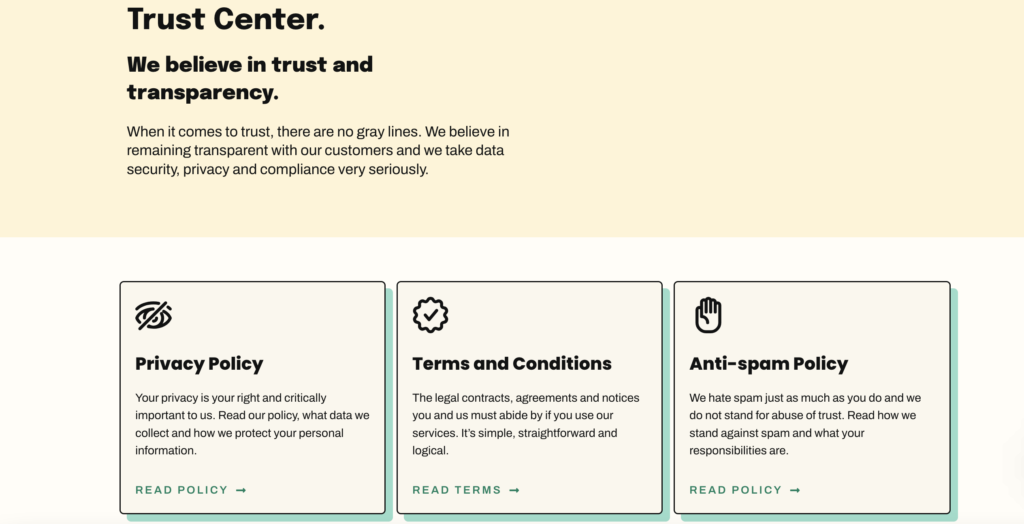
Comparison
When contrasting ConvertKit vs TinyEmail in the domain of security and compliance, both platforms showcase a profound commitment. While ConvertKit offers solid foundational security features, TinyEmail goes a step further with regular audits and a broader spectrum of compliance certifications. Ensuring data safety and adhering to international compliance standards is non-negotiable for both.
Mobile Optimization
The rise of mobile device usage has underscored the necessity for email marketing platforms to be impeccably optimized for mobile. As we further unravel the ConvertKit vs TinyEmail comparison, let’s delve into how each tool ensures a seamless mobile experience, both for the email recipients and the marketers.
ConvertKit
ConvertKit recognizes the ubiquity of mobile devices in modern digital interactions. Their email templates are designed to be inherently responsive, ensuring that emails appear flawlessly on screens of all sizes. For marketers on-the-go, ConvertKit offers a dedicated mobile app, which allows users to monitor campaigns, manage subscribers, and even draft emails right from their smartphones.

TinyEmail
TinyEmail champions the mobile-first approach. Every template within their library is crafted with mobile responsiveness at its core, ensuring optimal viewing and interaction across devices. Beyond the emails themselves, TinyEmail’s dashboard and features are available through a sophisticated mobile app. This app empowers marketers to initiate campaigns, segment audiences, and access analytics, all from the palm of their hand.

Comparison
When juxtaposing ConvertKit vs TinyEmail from a mobile optimization perspective, both platforms shine brightly. ConvertKit’s responsive templates and handy mobile app cater to the modern marketer’s needs. Simultaneously, TinyEmail’s profound commitment to a mobile-first philosophy ensures that both email recipients and marketers enjoy an unrivaled experience.
Feedback and Reviews
In the digital age, firsthand experiences and testimonials play a pivotal role in influencing purchasing decisions. As we dive deeper into the ConvertKit vs TinyEmail comparison, let’s glean insights from user feedback and industry reviews, shedding light on the strengths and potential concerns of each platform.
ConvertKit
ConvertKit boasts a plethora of positive reviews across various platforms. Many users commend its intuitive user interface, efficient automation tools, and responsive customer support. They appreciate the platform’s focus on catering to content creators, bloggers, and online entrepreneurs. Some criticisms revolve around its limited design customization options and occasional deliverability hiccups.

TinyEmail
TinyEmail, emerging as a new contender in the email marketing arena, has garnered a significant amount of positive buzz. Users often laud its streamlined dashboard, advanced segmentation capabilities, and competitive pricing. Its modern architecture and adaptive integrations have won many over. However, as with any tool, there are mentions of desired features yet to be introduced and initial learning curves for beginners.

Comparison
When weighing ConvertKit vs TinyEmail based on feedback and reviews, it’s evident that both platforms enjoy a considerable degree of user satisfaction. ConvertKit, with its legacy, has cemented its reputation among content creators. TinyEmail, although newer, is fast carving a niche for itself, backed by glowing testimonials and constructive feedback.
Scalability
In today’s rapidly evolving digital landscape, businesses are continually growing and adapting. As a result, the email marketing solutions they employ must be capable of evolving alongside them. Let’s delve into the ConvertKit vs TinyEmail debate, focusing on the scalability features each platform offers to accommodate businesses of varying sizes.
ConvertKit
ConvertKit, having been in the email marketing realm for a while, has made significant strides in scalability. Recognizing the diverse needs of its user base, from solo bloggers to large enterprises, ConvertKit offers a range of plans tailored to different subscriber counts. The platform ensures smooth performance regardless of the size of your email list. Its robust infrastructure can seamlessly handle spikes in email volumes, ensuring that your campaigns reach their intended recipients without a hitch.

TinyEmail
TinyEmail, although newer to the scene, showcases a modern architecture built with scalability at its core. Its cloud-based infrastructure guarantees uninterrupted service even as your campaigns increase in volume and complexity. Furthermore, TinyEmail’s adaptive design facilitates the addition of new features or integrations as your business needs grow. This ensures you always have the tools at your disposal to engage your expanding audience effectively.

Comparison
When examining scalability in the ConvertKit vs TinyEmail matchup, both platforms stand out for their forward-thinking approaches. ConvertKit’s established reputation and adaptive plans make it a reliable choice for businesses with growth in their forecast. On the other hand, TinyEmail’s flexible and modern design makes it a promising option for those who prioritize adaptability and future readiness.
Conclusion: ConvertKit vs TinyEmail
As we wrap up our detailed exploration of ConvertKit vs TinyEmail, it becomes evident that both platforms bring a unique set of features, strengths, and strategies to the table. Your decision should ideally hinge on the specific needs and goals of your business.
ConvertKit, with its time-tested reliability and comprehensive suite of tools, offers a robust platform suitable for businesses and individuals at various stages of growth. On the other hand, TinyEmail’s modern design, cloud infrastructure, and emphasis on adaptability make it an enticing choice for those looking to embrace future-ready email marketing solutions.
Choosing between these two platforms isn’t a matter of finding the “better” one but rather identifying which aligns more closely with your brand’s vision, audience engagement strategy, and scalability needs.
Remember, the realm of email marketing is ever-evolving. Continual research, learning, and adaptation are paramount. Whether you opt for ConvertKit or TinyEmail, the key is to harness the platform’s capabilities fully and consistently fine-tune your strategies to resonate with your audience.
Thank you for accompanying us on this journey. We hope this comparison equips you with the insights needed to make an informed choice. Whichever platform you choose, here’s to your success in all your email marketing endeavors!
Dive Deeper into the World of Email Marketing with Our Other Guides
Thank you for embarking on this in-depth exploration of ConvertKit vs TinyEmail with us. As you continue to hone your email marketing strategies and decide on the ideal platform, we encourage you to delve further into our existing range of detailed guides. Each piece has been crafted to offer you deeper insights and further refine your approach.
Expand Your Horizons: Comprehensive Comparisons and Expert Insights
- Mailchimp vs TinyEmail: An Exhaustive Examination: Navigate through the distinct features and offerings of Mailchimp and TinyEmail. From understanding the intricacies of automation to delving deep into their customer support nuances, this guide is designed to help you make informed choices.
- Moosend vs TinyEmail: The Ultimate Showdown: Delve into a thorough analysis comparing Moosend and TinyEmail. Assess which platform harmonizes best with your business’s unique needs and future aspirations.
Every guide in our collection is meticulously curated, ensuring you’re empowered with the latest insights and knowledge to spearhead your email marketing campaigns with confidence.
Your odyssey through email marketing promises myriad opportunities and revelations. As you devise compelling campaigns, adapt your strategies, or even venture into new methodologies, know that our reservoir of insights is here to guide and inspire you every step of the way.
Forge ahead, keep innovating, and remember: in the ever-evolving world of email marketing, staying informed and adaptable is the key.
Cheers to your continuous growth and achievements in the email marketing domain. Always stay curious and strive for excellence!


